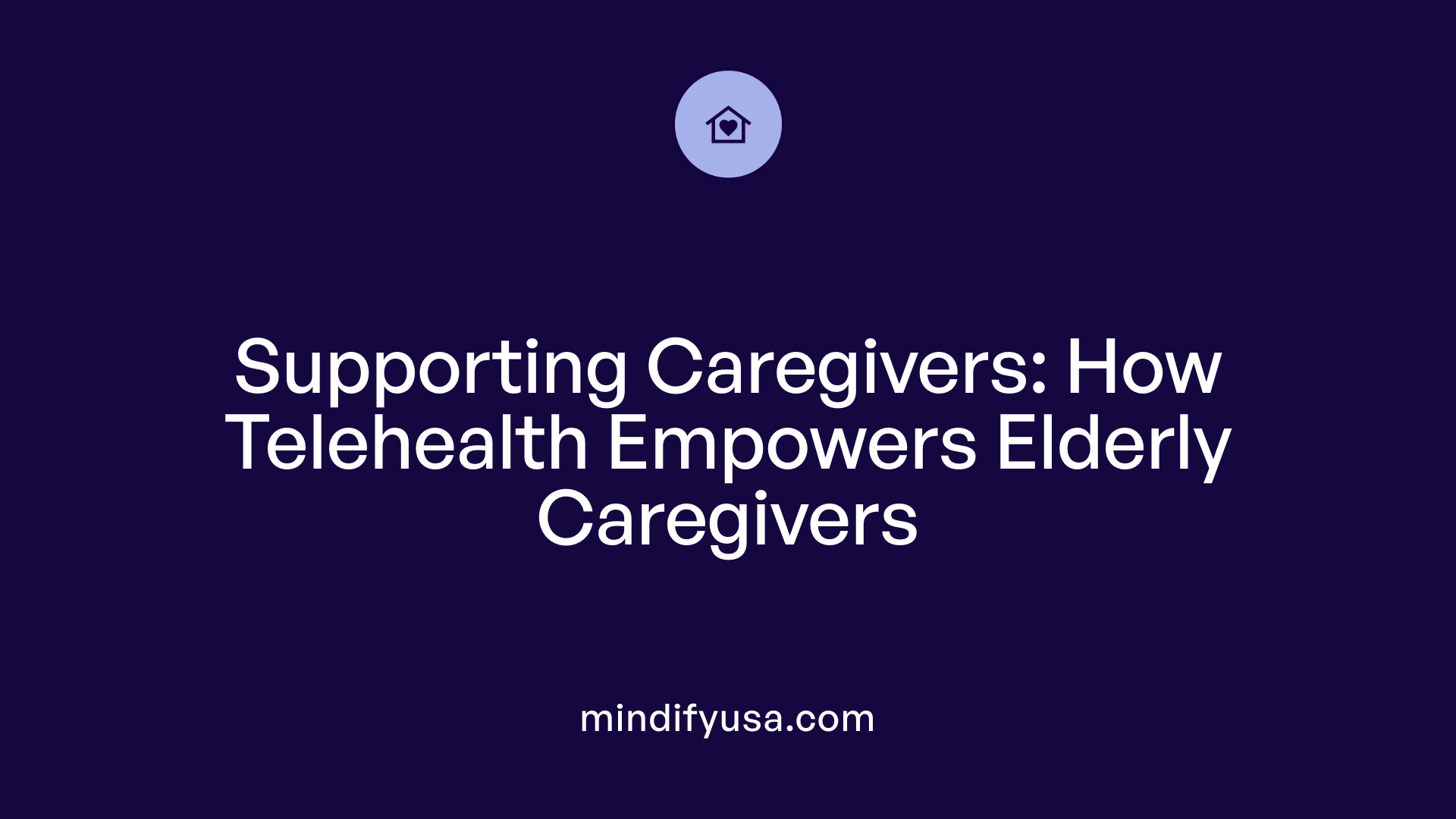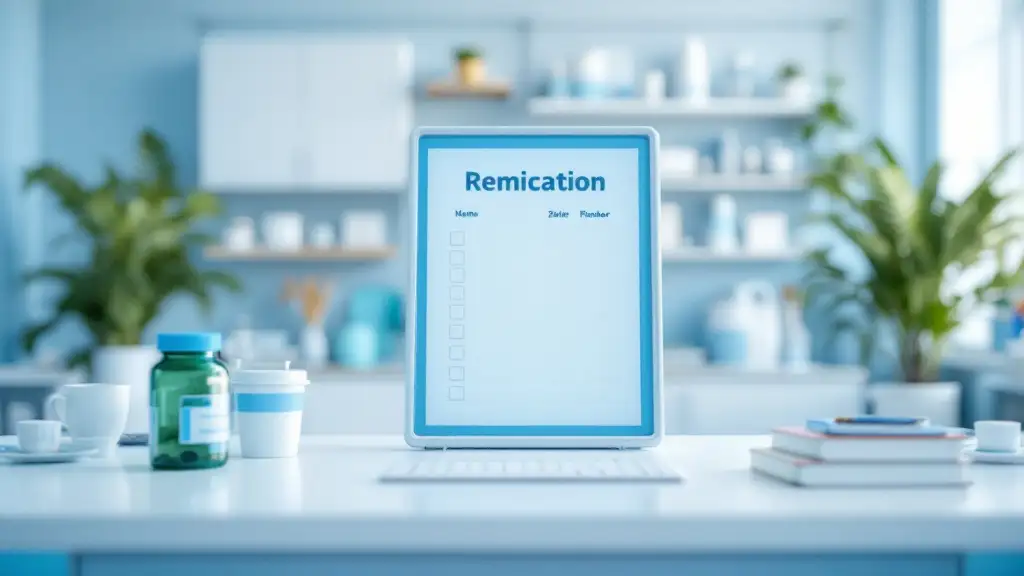Revolutionizing Support for Caregivers through Digital Innovation
Telehealth has emerged as a vital resource, transforming how caregivers of elderly patients access support, information, and healthcare services. Especially during the COVID-19 pandemic, its role became even more significant, offering remote care solutions that mitigate risks and bridge gaps created by mobility and access issues. This article explores how telehealth supports caregiving, highlights available tools, examines barriers and facilitators, and discusses strategies for optimal integration into elderly care practices.
The Impact of Telehealth During the COVID-19 Pandemic

How did telehealth impact elderly care during specific contexts like the COVID-19 pandemic?
The COVID-19 pandemic underscored the vital role of telehealth in elderly care. As in-person visits became risky due to infection concerns, telehealth enabled healthcare providers to continue offering essential services remotely. It improved access to healthcare for older adults facing mobility challenges or living in underserved rural areas, where transportation barriers are prevalent.
Telehealth facilitated a range of services such as wellness checks, mental health consultations, medication management, and remote monitoring, all vital for managing chronic conditions and maintaining overall health. Importantly, it helped reduce the exposure risk to COVID-19, safeguarding vulnerable populations.
To counter technological hurdles, many providers adopted strategies like offering devices, providing technical support, and involving caregivers more actively. This ensured both patients and their families could navigate the platforms effectively.
Although telehealth usage declined somewhat after the peak of the pandemic, it remained elevated compared to pre-pandemic levels, solidifying its role as a supplementary component of elderly healthcare. The experience highlighted the necessity for resilient infrastructure, caregiver training, and supportive policies to sustain and expand telehealth services.
Overall, telehealth proved essential for maintaining healthcare continuity, enabling timely interventions, and supporting elderly independence during a challenging period. Its positive impact demonstrated that with proper support, telehealth could effectively complement traditional care modalities in future healthcare strategies.
Supporting Caregivers: The Role of Telehealth

What is the role of telehealth in supporting caregivers of elderly patients?
Telehealth is transforming the way caregivers support their elderly relatives by offering remote healthcare access, education, and emotional support. It acts as an essential tool for enhancing caregiving capabilities, improving psychological well-being, and boosting confidence in managing health conditions.
One of the most significant advantages of telehealth is its ability to facilitate communication between caregivers, patients, and healthcare providers. Caregivers can participate in virtual visits, relay vital information, and receive guidance without the necessity of traveling to clinics. During the COVID-19 pandemic, many caregivers reported that telehealth increased access to care and reduced exposure risks, making healthcare delivery more practical and safer.
Moreover, telehealth supports caregivers through remote monitoring and intervention services such as psychoeducational resources, skills training, and counseling. These interventions, often delivered via video, web platforms, or telephone, have demonstrated substantial improvements in caregiver outcomes, including decreases in anxiety, depression, stress, and caregiver burden. Over 95% of studies reviewed showed significant benefits, underscoring telehealth’s effectiveness.
In addition to skill-building and mental health support, telehealth reduces logistical burdens such as transportation costs and time commitments. Particularly in rural or underserved urban areas, telehealth bridges gaps in access to specialized care and resources, allowing caregivers to better manage their loved ones’ health at home. Programs like STAR-Caregiver in Oregon exemplify how targeted telehealth strategies can increase engagement among rural caregivers of dementia patients.
Despite its advantages, implementing telehealth successfully involves overcoming barriers like technological literacy, internet connectivity, and concerns about privacy. Caregivers often assist with setting up platforms or troubleshooting issues, and tailored education initiatives can enhance their comfort and proficiency with these technologies.
To maximize telehealth’s benefits, healthcare systems should foster caregiver involvement actively, provide user-friendly platforms, and recognize the essential role caregivers play in ongoing monitoring and support. Policies encouraging caregiver participation, including during in-person visits when possible, are critical to ensuring holistic, patient-centered care.
In sum, telehealth serves as a vital support mechanism for caregivers, offering accessible, cost-effective, and comprehensive support that improves both caregiver well-being and patient health outcomes.
The Effectiveness of Telehealth Interventions

What does current research say about telehealth support for providing care to the elderly?
Recent systematic reviews and studies highlight that telehealth interventions have a positive impact on supporting caregivers of older adults, including those with chronic conditions such as dementia, stroke, and general geriatric health issues. An extensive review analyzing 65 studies published between 2002 and 2017 found that more than 95% reported significant improvements in caregiver outcomes such as reduced anxiety, depression, stress, and burden. Caregivers also experienced greater satisfaction, increased knowledge, and improved quality of life.
Telehealth services facilitate access to essential health interventions, especially benefiting those in rural or underserved urban areas. This includes remote monitoring, education, psychosocial support, and clinical consultations, which can help manage chronic diseases and support aging in place. For example, telehealth technologies like video calls, web-based platforms, and remote monitoring devices enable caregivers to stay connected with healthcare teams, improve communication, and monitor vital signs efficiently.
During the COVID-19 pandemic, caregivers reported that telehealth increased access to healthcare, reduced infection risk, and improved relationships with healthcare professionals. However, barriers such as older adults' difficulties with technology, internet connectivity issues, and concerns about the relevance of telehealth for certain health needs remain. Addressing these challenges involves caregiver training, user-friendly technology design, and policy support to promote broader adoption.
Overall, the evidence underscores telehealth’s potential to enhance elderly care significantly by improving access, reducing caregiver stress, and supporting health management, provided that infrastructural and educational hurdles are overcome.
Barriers and Facilitators in Telehealth Adoption
What are the barriers and facilitators to adopting telehealth for caregivers of the elderly?
Adopting telehealth services for caring for older adults presents both challenges and opportunities. Caregivers often face technological challenges, including limited digital literacy and difficulties navigating new platforms. Many elderly patients also encounter sensory impairments, such as hearing or vision difficulties, and cognitive limitations that make accessing and managing telehealth tools harder.
Connectivity issues, such as poor internet or unreliable devices, are common barriers, especially in rural or underserved areas. Security and privacy concerns further hinder acceptance, as caregivers worry about confidentiality and data protection. Additionally, many older adults are habituated to traditional in-person visits and may resist switching to digital formats.
Cost is another factor—while telehealth can reduce expenses related to transportation and caregiving, initial device and internet setup costs can be discouraging for some families. Lack of user-friendly technology, insufficient promotion of telehealth benefits, and inadequate social support also limit adoption.
Nonetheless, several facilitators help promote telehealth use. Designing platforms that are easy to operate with simple interfaces, large buttons, and clear instructions encourages participation. Providing training for caregivers and patients to gain confidence with technology boosts acceptance.
Healthcare providers’ professionalism, trustworthiness, and effective communication build confidence in telehealth options. The COVID-19 pandemic accelerated acceptance by highlighting the convenience and safety of remote care, demonstrating that telehealth can facilitate regular checkups, support chronic disease management, and maintain social connections.
Engaging caregivers in the development and implementation of telehealth services ensures that the tools meet their needs and that they feel supported throughout the process. Establishing reliable infrastructure and investing in digital literacy programs are essential steps to remove barriers.
In summary, overcoming technological hurdles, increasing awareness, and fostering trust are crucial for expanding telehealth access for families caring for elderly relatives. As these barriers diminish, caregivers are more likely to embrace telehealth, improving health outcomes and quality of life for older adults.
Practical Strategies to Maximize Telehealth Effectiveness

What are some practical strategies for implementing telehealth support for caregivers?
Implementing telehealth support effectively requires a comprehensive approach focused on training, technical support, and personalized interventions.
First, caregivers should receive detailed training on how to navigate and use telehealth platforms, including video conferencing, remote monitoring devices, and secure messaging systems. Providing user-friendly guides, step-by-step tutorials, and hands-on workshops can significantly boost confidence and competence.
Secondly, consistent technological support is crucial. This can include real-time assistance during telehealth visits, troubleshooting help, and resources to improve digital literacy, especially tailored for older caregivers or relatives with sensory or cognitive impairments.
Integrating telehealth into routine health care workflows helps normalize its use. Leadership support from healthcare organizations, along with clear policies, encourages staff and caregivers to adopt these tools.
Tailoring interventions to meet specific caregiver and patient needs enhances engagement. Strategies such as skills training, psychoeducational resources, and psychosocial support—delivered via modifiable modalities like telephone, web, or a combination—are effective.
Active caregiver involvement in program design, ongoing feedback, and addressing concerns about privacy and security further enhance satisfaction and participation.
By leveraging diverse telehealth modalities—video, web platforms, remote monitoring—and evidence-based practices, healthcare providers can expand access, especially in rural or underserved areas, reduce caregiver burden, and support better health outcomes for elderly patients.
Policy Considerations for Integrating Telehealth into Elderly Care
What policy considerations are important for integrating telehealth into caregiving support systems?
Successful integration of telehealth services into elderly caregiving requires careful policy planning that addresses multiple factors. One of the most critical aspects is reimbursement. Policies should ensure that telehealth visits receive equitable pay, similar to in-person care, across all insurance providers including Medicare, Medicaid, and private insurers. This parity encourages healthcare providers to adopt and sustain telehealth services.
Licensure regulations also play a pivotal role. Reforms such as expanding practice agreements across state lines and adopting the Interstate Medical Licensure Compact can increase provider availability, particularly in rural or underserved areas. This helps to overcome regional shortages and brings specialized services closer to elderly patients.
Equally important are privacy and security policies. Telehealth platforms must strictly adhere to regulations like the Health Insurance Portability and Accountability Act (HIPAA). Clear guidelines for obtaining informed consent, preserving patient privacy, and managing the prescribing of controlled substances are vital for patient safety and legal compliance.
Infrastructure is another essential policy domain. Expanding broadband access and supporting technological readiness can bridge digital divides. For rural or low-income areas, removing restrictions on originating sites—such as limiting telehealth to certain clinics or hospitals—and including audio-only options can make telehealth more accessible to those with limited internet connectivity or digital literacy.
Continuous policy development is necessary to adapt to technological advancements and changing healthcare needs. Engaging stakeholders—including caregivers, providers, and policymakers—can help shape effective regulations. Post-public health emergency policies should be stabilized to maintain service quality, safety standards, and equitable access.
Overall, a comprehensive policy framework that includes equitable reimbursement, licensure flexibility, strict privacy protections, infrastructure investments, and ongoing stakeholder engagement is crucial to embed telehealth as a sustainable, effective component of elderly caregiving support.
Enhancing Telehealth for Elderly Care through Community and Cultural Approaches
How can community-based programs improve telehealth services for the elderly?
Community-based programs are essential in bridging the gap between technology and older adults. These programs provide tailored training sessions, access points like local centers, and ongoing support to help seniors navigate telehealth platforms. For example, initiatives such as the STAR-Caregiver Program in Oregon include remote coaching and workshops that boost caregivers' confidence in using telehealth, particularly in rural areas.
Why is cultural competence important in telehealth for elderly patients?
Cultural sensitivity in telehealth ensures that services are respectful and relevant to diverse populations. Providing care in different languages, understanding cultural health beliefs, and respecting communication preferences increase trust and engagement. Healthcare providers trained in cultural competency can better address specific needs, making telehealth more accessible and effective for minority and immigrant elderly populations.
How can technology literacy initiatives support elderly users?
Technology literacy initiatives are crucial for overcoming barriers related to digital skills. Educational workshops, user-friendly guides with large text and simple instructions, and personalized technical support help seniors learn how to operate devices and telehealth platforms. Enlisting caregivers as part of these initiatives enhances the learning process, ensuring that elderly individuals feel supported and confident in managing their virtual health visits.
What policies can support a culturally sensitive telehealth infrastructure?
Supportive policies include funding for community outreach, training programs, and technology access. Governments and health organizations should advocate for regulations that mandate cultural competence training for providers and ensure language services are integrated into telehealth platforms. Additionally, policies that expand internet access—like the Lifeline program—help reduce disparities, making telehealth a viable option for all elderly populations.
| Strategy | Description | Expected Outcome |
|---|---|---|
| Community programs | Local education, training, and support initiatives | Increased familiarity and confidence in telehealth |
| Cultural competence training | Provider education on cultural and language needs | Higher engagement and trust in telehealth services |
| Technology literacy efforts | Workshops, guides, caregiver involvement | Improved digital skills and independence |
| Supportive policies | Funding, internet access, language services | Reduced disparities, broader access |
By focusing on community involvement, cultural understanding, and policy support, telehealth can become more inclusive and effective for elderly care, ensuring that all seniors can benefit from remote healthcare options.
Conclusion: The Future of Telehealth in Elderly Care Support
Long-term Implications for Elderly Care
The integration of telehealth into elderly care is poised to reshape how support is delivered over the coming decades. As technology becomes more advanced and widespread, telehealth services will likely become a staple in managing chronic conditions, enhancing home care, and promoting aging in place. Consistent caregiver involvement can reduce hospitalizations and emergency visits, ultimately improving health outcomes and quality of life for older adults.
Technological Innovations on the Horizon
Emerging tools like remote monitoring devices, wearable health technology, and user-friendly telehealth platforms will continue to evolve. These innovations will facilitate real-time health monitoring, early detection of health issues, and more personalized care. For example, devices such as smartwatches and specialized home sensors are already giving caregivers and clinicians valuable data, enabling proactive interventions.
Addressing Equity and Improving Access
Ensuring equitable access remains crucial. Rural and underserved populations benefit greatly from telehealth, as it reduces barriers related to transportation and geographic isolation. Future efforts must focus on digital literacy programs, affordable internet options like the Lifeline program, and culturally sensitive services to bridge gaps in care. Policymakers and healthcare providers should prioritize infrastructure enhancements and training, so technology serves all populations equally.
The Role of Caregivers Moving Forward
Caregivers will continue to be vital in maximizing telehealth’s benefits. Training and supporting caregivers, especially in technology use, will help address barriers like digital literacy and privacy concerns. Programs that actively involve caregivers in telehealth visits—whether for technical assistance or emotional support—can lead to better engagement and health outcomes.
| Aspect | Focus | Future Directions |
|---|---|---|
| Technology | Advanced remote monitoring, user-friendly platforms | Development of seamless, accessible devices that integrate health data efficiently |
| Accessibility | Rural and underserved communities | Expansion of programs to reduce digital divides, improve device availability |
| Caregiver Role | Engagement and training | Continuous education, involving caregivers in policy shaping, and fostering collaborative care models |
| Policy | Support for full caregiver participation | Legislation to ensure privacy, interoperability, and inclusion in telehealth planning |
The future of telehealth in elderly care support promises a more connected, accessible, and personalized healthcare experience—one where caregivers are empowered and older adults can thrive in their homes longer than ever before.
Charting a Path Forward for Elderly Care Through Telehealth Innovation
The integration of telehealth into elderly caregiving support has demonstrated significant benefits, including improved access, enhanced caregiver skills, and better health outcomes. While barriers such as technological literacy, connectivity, and privacy concerns remain, ongoing innovations, policy reforms, and community engagement are vital to overcoming these challenges. The COVID-19 pandemic underscored the essential role telehealth can play in ensuring continuity of care among vulnerable populations. Moving forward, investments in infrastructure, tailored training programs, and inclusive policies will be critical to maximizing telehealth’s potential, making it a sustainable and equitable foundation for supporting elderly caregivers and promoting healthy aging in place.
References
- Telehealth Interventions for Family Caregivers of Persons with ...
- Telehealth Services for the Elderly Should Include Caregivers | News
- A systematic review of telehealth tools and interventions to support ...
- Implementation Considerations for Telehealth Programs Serving ...
- Telehealth Simplifies Support for Elderly Parents and Their Caregivers
- Maximizing Telehealth for Elderly Patients - Updox
- Factors that influence the preferences for telehealth among family ...
- Preparing older adults for telehealth






































































































